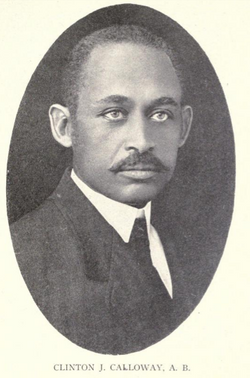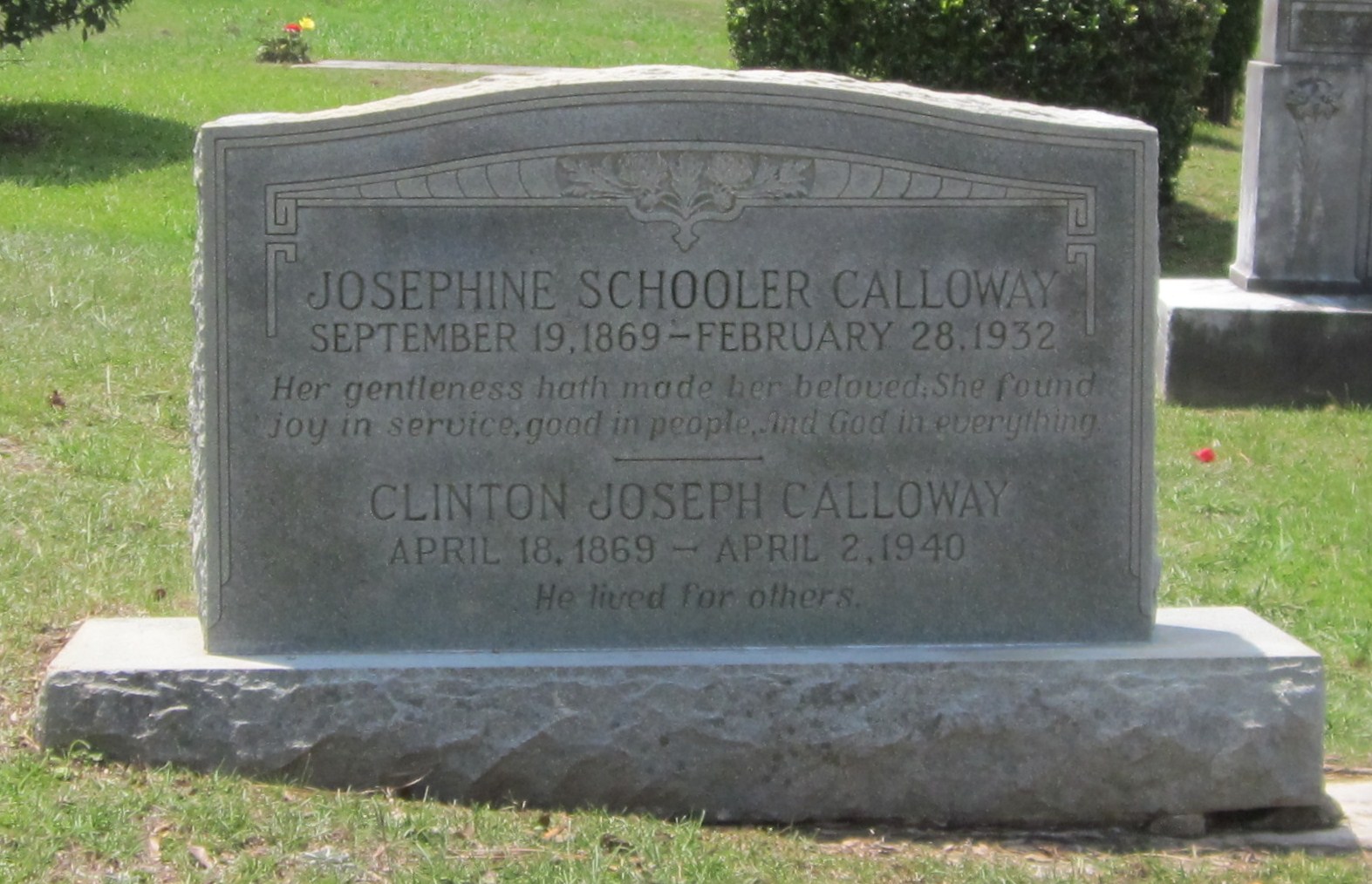A suggestion to Tuskegee’s president, Booker T. Washington, by Cleveland native, Clinton J. Calloway, who served as the director of the college’s Extension Department was to gain the financial support for erecting modern school building from Julius Rosenwald of Chicago. Rosenwald was part owner and president at Sears, Roebuck and Company. The success of this seemingly small suggestion began what became the largest output of effort for rural school building and uplifting of education since slavery was abolished.
Calloway was born April 18, 1869 to former slaves George and Elizabeth (Grant) Calloway. Prior to his birth, his father and two uncles, William Calloway and Leander Grant, became trustees in the establishment of the Freedom’s school in Cleveland. He relocated to Alabama in 1895, after graduation from Fisk. He was recruited by William E. Benson, a fellow classmate, to become principal of a new black secondary vocation school in Elmore County, Alabama, named the Kowaliga Academic and Industrial Institute. Calloway joined the Tuskegee Extension Department and turned a one-teacher shanty at Kowaliga plantation into a three-building, eleven-teacher plant that was in session eight-months of the year. Following this accomplishment, he returned to Tuskegee to become the primary advocate for the Macon County Schools. Primarily, Booker T . Washington brought Calloway to Tuskegee as a special assistant to George Washington Carver.
Prior to the Rosenwald connection, according to Ellen Wiess in her book, Robert R. Taylor and Tuskegee, “Around 1904, Washington lured the Standard Oil executive Henry Huddleston Rogers and the Philadelphia heiress Anna T. Jeans (1907) into the endeavor. “Rogers gave perhaps as many as forty-two school buildings for eight- or nine- month sessions were completed between 1905 and 1911.” Since the educational outreach program was under new Agriculture Extension Department, beginning in 1905, Calloway was responsible for the management of the applications for each school, the building and disbursing the funding for each school. He devoted his time to expanding educational opportunities for African-American through the management of the Anna T. Jeanes Fund, which made it possible for counties in southern states to fund the first home economics teachers; the Smith-Hughes Appropriation for Vocational Education; and, the Julius Rosenwald Fund (1911). Between 1914 and 1915, Calloway managed the fundraising for and the construction of twenty-one schools in six counties.
In 1915, the Extension Department at Tuskegee Normal and Industrial Institute published a document entitled: The Negro Rural School and Its Relation to the Community. The Forward states: “…The designs for the buildings and grounds have been approved by the State Department of Education of Alabama. Communities in Alabama erecting buildings according to these plans may therefore feel assured that they will be accepted by the State. The thanks of the Department are also extended to Mr. Robert R. Taylor, Director of the Department of Mechanical Industries, and to W. A. Hazel, of the Division of Architecture, for the execution of the plans and specifications of the building presented, and to Professor G. W. Carver, of the Department of Agricultural Research; for the material on school grounds, gardens and demonstration plots.”
“By 1920, 638 schools had been built under Calloway’s management. During that year, Rosenwald decided to move his program to Nashville, Tennessee, and hired Samuel L. Smith as its administrator, thus severing the program from Tuskegee and ended the racial intimacy of black professionals working with black communities.”
At the age of 66, Calloway retired from Tuskegee in 1935. He died on April 2, 1940 and is buried in the Tuskegee University Cemetery.
Dana R. Chandler
University Archivist/Associate Professor
Tuskegee University Archives, A Division of Library Services
A suggestion to Tuskegee’s president, Booker T. Washington, by Cleveland native, Clinton J. Calloway, who served as the director of the college’s Extension Department was to gain the financial support for erecting modern school building from Julius Rosenwald of Chicago. Rosenwald was part owner and president at Sears, Roebuck and Company. The success of this seemingly small suggestion began what became the largest output of effort for rural school building and uplifting of education since slavery was abolished.
Calloway was born April 18, 1869 to former slaves George and Elizabeth (Grant) Calloway. Prior to his birth, his father and two uncles, William Calloway and Leander Grant, became trustees in the establishment of the Freedom’s school in Cleveland. He relocated to Alabama in 1895, after graduation from Fisk. He was recruited by William E. Benson, a fellow classmate, to become principal of a new black secondary vocation school in Elmore County, Alabama, named the Kowaliga Academic and Industrial Institute. Calloway joined the Tuskegee Extension Department and turned a one-teacher shanty at Kowaliga plantation into a three-building, eleven-teacher plant that was in session eight-months of the year. Following this accomplishment, he returned to Tuskegee to become the primary advocate for the Macon County Schools. Primarily, Booker T . Washington brought Calloway to Tuskegee as a special assistant to George Washington Carver.
Prior to the Rosenwald connection, according to Ellen Wiess in her book, Robert R. Taylor and Tuskegee, “Around 1904, Washington lured the Standard Oil executive Henry Huddleston Rogers and the Philadelphia heiress Anna T. Jeans (1907) into the endeavor. “Rogers gave perhaps as many as forty-two school buildings for eight- or nine- month sessions were completed between 1905 and 1911.” Since the educational outreach program was under new Agriculture Extension Department, beginning in 1905, Calloway was responsible for the management of the applications for each school, the building and disbursing the funding for each school. He devoted his time to expanding educational opportunities for African-American through the management of the Anna T. Jeanes Fund, which made it possible for counties in southern states to fund the first home economics teachers; the Smith-Hughes Appropriation for Vocational Education; and, the Julius Rosenwald Fund (1911). Between 1914 and 1915, Calloway managed the fundraising for and the construction of twenty-one schools in six counties.
In 1915, the Extension Department at Tuskegee Normal and Industrial Institute published a document entitled: The Negro Rural School and Its Relation to the Community. The Forward states: “…The designs for the buildings and grounds have been approved by the State Department of Education of Alabama. Communities in Alabama erecting buildings according to these plans may therefore feel assured that they will be accepted by the State. The thanks of the Department are also extended to Mr. Robert R. Taylor, Director of the Department of Mechanical Industries, and to W. A. Hazel, of the Division of Architecture, for the execution of the plans and specifications of the building presented, and to Professor G. W. Carver, of the Department of Agricultural Research; for the material on school grounds, gardens and demonstration plots.”
“By 1920, 638 schools had been built under Calloway’s management. During that year, Rosenwald decided to move his program to Nashville, Tennessee, and hired Samuel L. Smith as its administrator, thus severing the program from Tuskegee and ended the racial intimacy of black professionals working with black communities.”
At the age of 66, Calloway retired from Tuskegee in 1935. He died on April 2, 1940 and is buried in the Tuskegee University Cemetery.
Dana R. Chandler
University Archivist/Associate Professor
Tuskegee University Archives, A Division of Library Services
Inscription
He lived for others.
Family Members
Sponsored by Ancestry
Advertisement
Records on Ancestry
Advertisement













